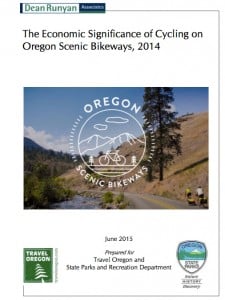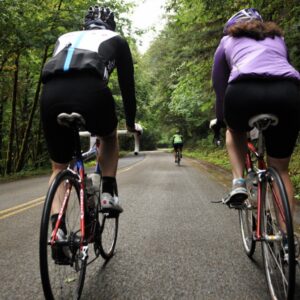
Results from the first study of Oregon’s Scenic Bikeways are in: The 12 carefully selected routes that showcase the best road riding in the state accounted for $12.4 million in economic activity in 2014.
The Economic Significance of Cycling on Oregon Scenic Bikeways, commissioned by Travel Oregon and Oregon State Parks and Recreation Department, was published earlier this month by Dean Runyan Associates. The study gathered data on overall usage of the bikeways as well as where money was spent and the bikeways’ impacts on job creation.
Scenic bikeways are the backbone of the State of Oregon’s strategic focus on bicycle tourism — an industry that pumps $400 million into our economy each year. The program was established by law in 2008 and the first scenic bikeway became official in 2009.
Of the $12.4 million spent while riding scenic bikeways, this latest study found that $6.9 million was spent on accommodation and food, $5.3 million on retail goods (including snacks, groceries and gas) and another $182,000 was spent on arts, entertainment, and recreation (including cycling event fees).
Advertisement
The towns these routes go through also benefit. The study found that cycling created 150 jobs and $3.4 million in total earnings while creating local and state tax receipts of $454,000.
Of the 12 scenic bikeways that were included in the study, the Willamette Valley Scenic Bikeway had the most action. Using data from RideWithGPS, Strava, and official ODOT hose counts, the study counted 18,700 bike trips on that route, with 9,800 overnighters and 8,900 day rides. In total, people took an estimated 79,200 trips on the 12 twelve bikeways (split evenly between overnighters and day rides).
The study also gleaned demographic data from riders. 65 percent of them were male and 35 percent were female. The majority (63 percent) were over 50 years old and had an annual income of $75,000. (No data about ethnicity was shared in the study.)






Thanks for reading.
BikePortland has served this community with independent community journalism since 2005. We rely on subscriptions from readers like you to survive. Your financial support is vital in keeping this valuable resource alive and well.
Please subscribe today to strengthen and expand our work.
Interesting data, do you know how much was spent to create the bikeways by the state? Would be nice to be able to see the ROI on these programs.
I agree. Interesting data. But the framing bothers me.
If I am reading this report correctly, wealthy people biking on these routes and staying in hotels are considered a success, while people like me who pack three days of food and camp on the roadside and don’t spend any money, or only a little at a grocery store along the way are not evidence of the kind of success the sponsors are looking for. I realize this spending-as-measure-of-success bias is much greater than this study, but I’m going to lament it since it came up here. We are so much more than how much we spend; enjoyment does not track spending. I can have just as much fun biking to Glacier National Park from here, camping and spending almost nothing, as someone who stays in hotels along the way (or perhaps even more).
I’d have preferred if the number of people cycling were given more prominence, quite apart from the millions spent along the way.
If a tree falls in the woods but doesn’t stop to buy candy bars, chips and a beer at the one market in town do the towns folk hear it or care?
1) True
2) Welcome to America, pilgrim
3) A bigger issue I see in the near term is the trend towards using chip seal as a cheaper substitute for repaving roads. Last year on the Cycle Oregon week ride, I bet 2/3 of the roads were recently chip-sealed, making them terrible to ride on. Without shocks, every bump is transmitted directly to the rider, try enjoying that over your next 400+ mile ride. What a difference when we’d hit one of the apparently disappearing sections of older standard pavement: the buzzing vibration stopped, the sun came out and birds began singing again, or at least that’s the way it seemed. Just at the time Oregon is establishing all these great Scenic Bikeway routes hoping to attract bicycle tourism they’re taking away half the fun (seriously) by going cheap on the road surface. I think they’re making a serious mistake, economically speaking.
(1) put fatter tires on your bike so you don’t notice the slight imperfections of chipseal;
(2) persuade ODOT to devote even more of their shrinking budget to asphalt;
(2)(a) support a real worthy-of-the-name gas tax so we can actually maintain our infrastructure properly
Weird, I just read this:
The Economic Significance of Cycling on Oregon Scenic Bikeways
Funny how a title like that doesn’t take into account intangible factors like “enjoyment.” Let me know when someone comes up with a way to measure that, and if local businesses along these routes start taking it as currency. I’d sure like to justify building more bike infrastructure and pay in enjoyment. How much enjoyment would the mom & pop stores have to provide to their employees in lieu of money to be equitable?
O.K. I concede: the study is looking at economic significance.
From the report’s introduction:
The Oregon Scenic Bikeway program is a superb collection of cycling routes that inspires people to experience Oregon’s natural beauty and cultural heritage by bicycle, and that offers economic and social benefits to the state’s communities and residents.
If I read that correctly, those are two sets of objectives; the economic benefits are one of several reasons these cycling routes were established.
I think my larger point remains: why is the economic impact privileged? We are, after all, talking about public funds, are we not? Do we also evaluate libraries or sidewalks or street lighting or swimming pools this way?
There’s a pot of money for economic development in rural communities. Some of that money gets spent promoting scenic bike routes, because touring cyclists spend money.
http://www.opb.org/news/article/oregon-scenic-bikeways-contribute-124-million-in-economic-activity/
‘Jennie Shaw runs the Hotel Prairie in Prairie City. She estimates that cyclists make up 50 percent of her bookings. “It’s definitely our bread and butter,” Shaw said.’
If cyclists really have a great time but they don’t spend any money like you do when you camp then why is the state taking a pot of money to help people like Jennie Shaw and spending it on cyclists instead? You would have to find a different pot of public funds to pay for the scenic bike route signs and maps and promotions.
“You would have to find a different pot of public funds to pay for the scenic bike route signs and maps and promotions.”
I guess another way to rephrase what I’m asking—and your points are helping me to refine it—is why would that be up to me? Who is making the upstream decision that recreational cycling is appropriately funded with economic development dollars? And why? I’ll ask again – is that how we fund swimming pools or libraries?
http://bikeportland.org/2015/07/07/guest-article-biking-cheap-145985#comment-6461931
(1) wouldn’t fatter tires mask the slight imperfections of chipseal?
(2) persuade ODOT to devote even more of their budget to asphalt.